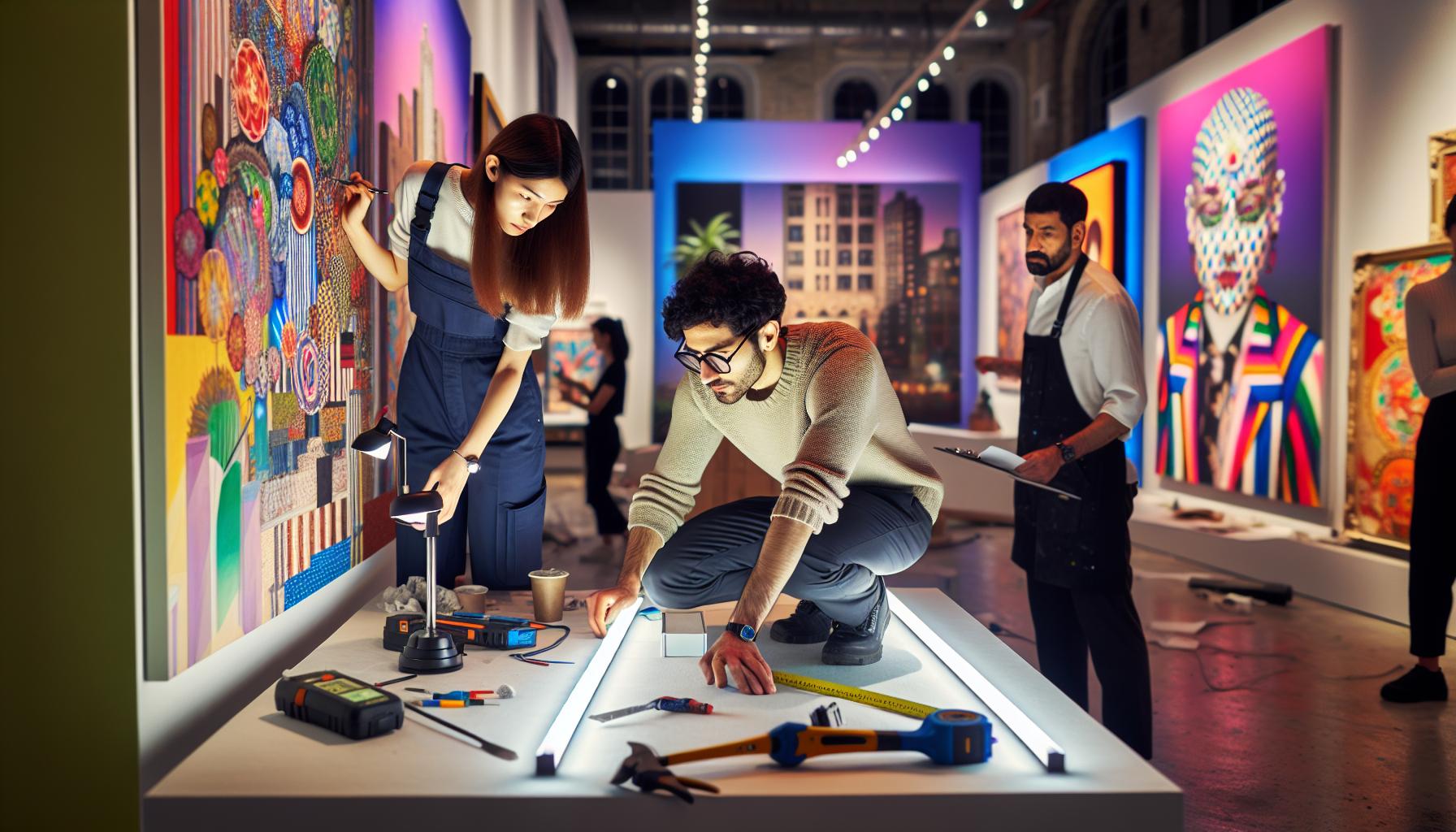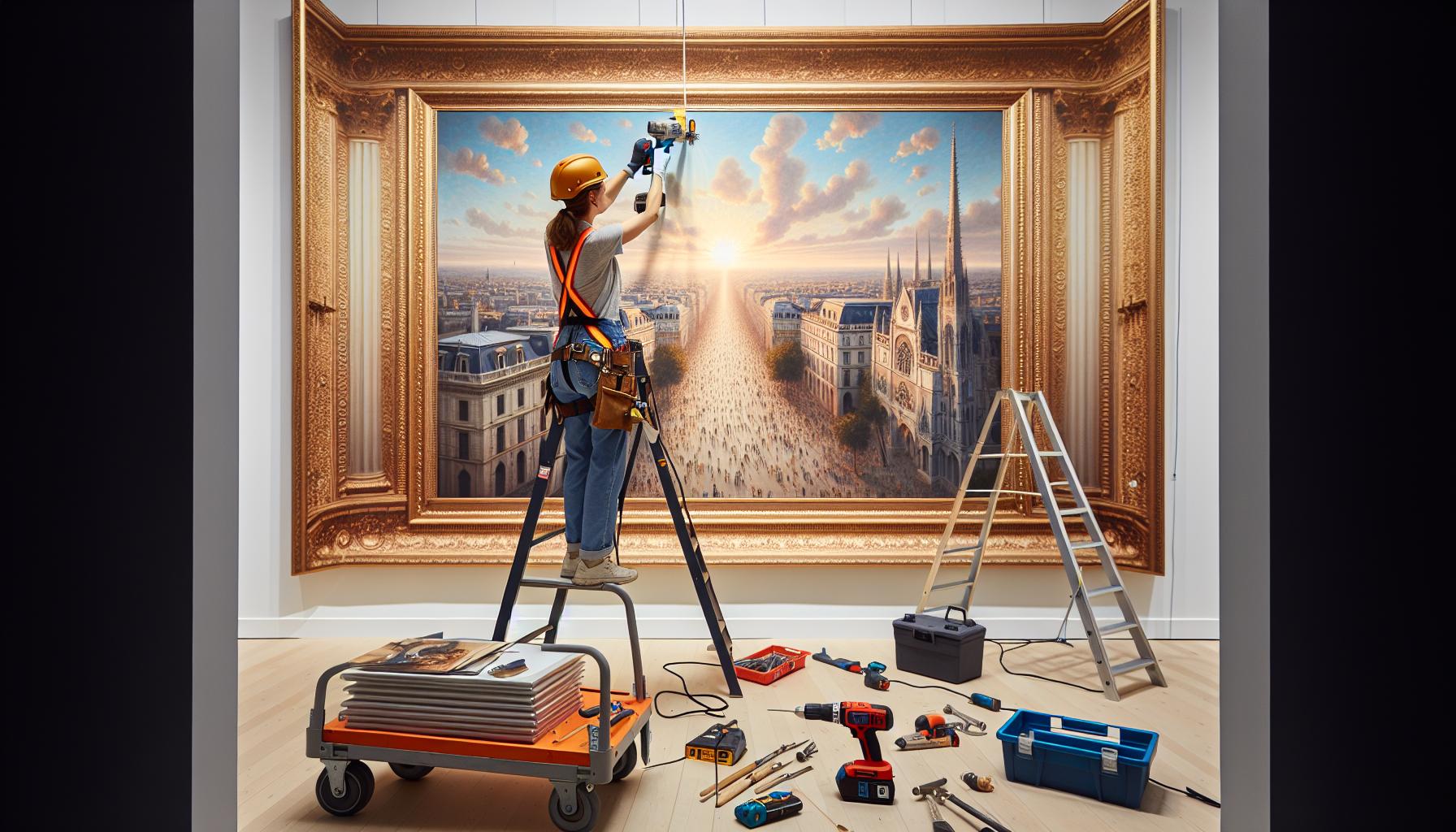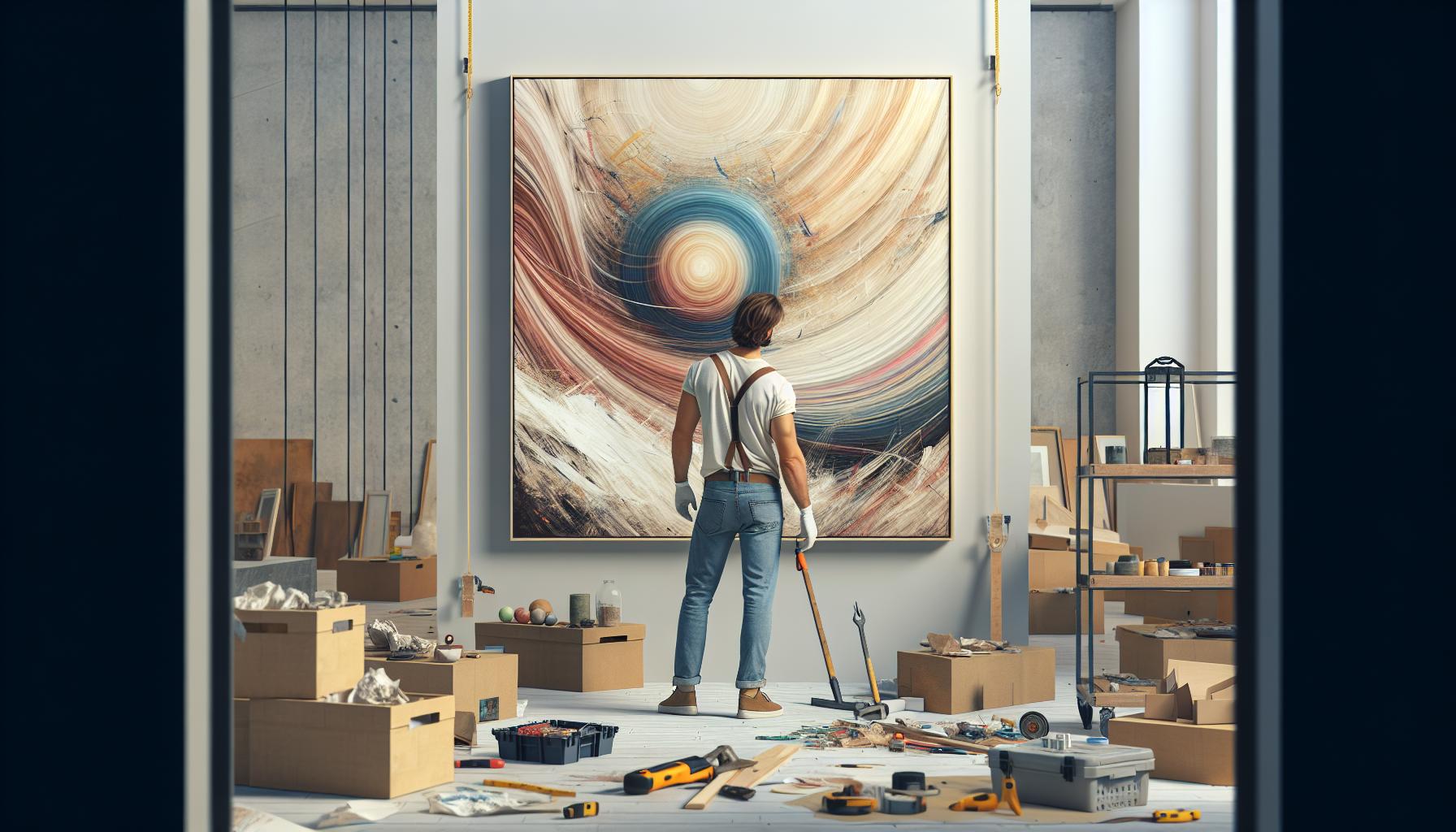Ever wondered who transforms empty gallery spaces into mesmerizing works of art? Art installation professionals are the behind-the-scenes wizards who bring artistic visions to life in museums galleries and public spaces. These skilled individuals combine technical expertise with creative sensibility to mount display and preserve artwork for audiences worldwide.
The art installation field offers diverse career opportunities for those passionate about both art and hands-on work. From carefully handling priceless paintings to constructing complex sculptural displays these professionals need steady hands expert knowledge and impeccable attention to detail. It’s a career path that’s both challenging and rewarding offering the chance to work directly with renowned artists and iconic cultural institutions.
Art Installation Jobs
Art installation jobs involve specialized professionals who handle the physical placement positioning of artwork in galleries museums commercial spaces. Installation specialists execute precise mounting techniques for paintings sculptures mixed media pieces while maintaining strict preservation standards.
Key responsibilities include:
- Measuring gallery spaces to determine optimal artwork placement
- Operating lifting equipment to transport heavy art pieces
- Installing security systems lighting fixtures to protect display pieces
- Collaborating with curators to achieve desired aesthetic arrangements
- Following conservation protocols during artwork handling
- Creating custom mounts brackets supports for unique pieces
Installation roles vary across different settings:
| Setting Type | Primary Focus | Technical Requirements |
|---|---|---|
| Museums | Preservation | Climate control expertise |
| Galleries | Presentation | Lighting design skills |
| Public Spaces | Durability | Engineering knowledge |
| Private Collections | Security | Protection systems |
Art installers work with diverse materials tools:
- Hand tools measuring devices for precise mounting
- Digital layout software for space planning
- Climate monitoring equipment
- Custom fabrication materials
- Specialized art handling gloves protective gear
- Transportation rigging equipment
The position demands both technical expertise artistic sensitivity. Installers coordinate with:
- Museum curators
- Gallery directors
- Conservation specialists
- Lighting designers
- Security personnel
- Shipping logistics teams
- Fine arts background
- Object handling certification
- OSHA safety training
- Equipment operation licenses
- Insurance liability coverage
- Documentation expertise
Types of Art Installation Careers

Art installation professionals work across diverse environments with specialized roles tailored to specific venue requirements. Each career path demands unique skills sets ranging from artifact preservation to large-scale public installations.
Museum Installation Specialists
Museum installation specialists focus on preserving priceless artifacts while creating engaging displays. These professionals utilize conservation techniques to maintain optimal temperature, humidity, and lighting conditions for delicate artworks. They operate specialized mounting systems, manage climate control equipment, and implement security protocols for valuable collections. Museum specialists collaborate with curators to arrange exhibitions that balance aesthetic impact with artifact preservation requirements. Their expertise includes handling ancient artifacts, coordinating with conservation teams, and documenting installation procedures for future reference.
Gallery Preparators
Gallery preparators transform commercial art spaces into cohesive exhibition environments. They excel at rapid installation turnovers, managing multiple shows throughout the year. Preparators handle artwork transportation, create custom mounting solutions, and adjust lighting systems to enhance visual presentation. Their responsibilities include condition reporting, space planning, and collaborating with artists to realize their creative visions. Gallery preparators maintain flexible schedules to accommodate opening deadlines, private viewings, and art fair installations.
Public Art Installers
Public art installers specialize in large-scale outdoor installations that withstand environmental conditions. They coordinate with engineers to ensure structural integrity, manage heavy equipment operations, and implement safety protocols for public spaces. These professionals navigate municipal permits, conduct site surveys, and oversee foundation preparation for permanent installations. Public art installers work with weather-resistant materials, handle specialized lifting equipment, and maintain compliance with local building codes. Their projects include sculptures in parks, murals on buildings, and interactive installations in urban spaces.
Required Skills and Qualifications

Art installation professionals combine technical proficiency with artistic knowledge to handle valuable artwork safely and create compelling displays. The role demands specific expertise across multiple domains to ensure successful installations.
Technical Expertise
Professional art installers demonstrate mastery in specialized installation tools including laser levels, power drills, mounting hardware systems. Their skill set encompasses digital design software like AutoCAD, SketchUp for space planning, exhibition layouts. Experience with lighting systems proves essential for creating optimal viewing conditions through track lighting adjustment, color temperature control. Knowledge of conservation principles includes humidity monitoring, temperature control methods, UV protection techniques. Proficiency in art handling equipment operation spans fork lifts, hydraulic lifts, specialized art carts. Understanding of security systems integration involves electronic monitoring devices, motion sensors, climate control systems.
Physical Requirements
Art installation demands substantial physical capabilities for tasks lasting 8-10 hours daily. Core strength supports lifting objects weighing up to 50 pounds independently, 100 pounds with assistance. Mobility requirements include climbing ladders, operating scissor lifts, maneuvering in tight spaces. Hand-eye coordination facilitates precise measurements, delicate artwork handling, tool manipulation. Standing for extended periods on various surfaces like concrete, scaffolding, wooden platforms remains essential. Dexterity enables detailed work with small hardware, lighting adjustments, mounting brackets. Balance skills support working at heights, carrying artwork safely, maintaining steady hands during installation.
Where to Find Art Installation Work

Art installation opportunities exist across diverse venues in the cultural sector. Each setting offers unique challenges while requiring specific expertise in artwork handling preservation techniques.
Museums and Cultural Institutions
Museums post art installation positions on specialized job boards like AAM JobHQ the American Alliance of Museums career center. Large institutions including The Metropolitan Museum of Art MoMA The Smithsonian maintain dedicated career portals featuring preparator exhibition designer art handler roles. Cultural centers frequently hire through professional networks such as the International Council of Museums LinkedIn museum groups art handling forums. Local arts councils community centers historic sites also employ installation specialists for permanent rotating exhibitions. Museum registrars regularly contract freelance art installers through established industry contacts preservation societies.
Private Art Galleries
Commercial galleries advertise installation opportunities through arts-focused job sites like NYFA ArtJobs Gallery Jobs Now. Major gallery networks including Pace Gagosian David Zwirner list positions on their websites company career pages. Regional gallery associations maintain job boards connecting installers with member galleries needing exhibition support. Art fairs provide seasonal installation work particularly during major events like Art Basel Frieze TEFAF. Gallery preparators build professional connections at industry events dealer associations art handling workshops. Smaller galleries often recruit through word-of-mouth recommendations from trusted art professionals curators collectors.
Salary and Career Growth
Art installation professionals earn an average base salary of $45,000 to $65,000 annually, with experienced specialists in prestigious institutions commanding up to $85,000. Senior positions in major metropolitan museums offer competitive benefits packages including health insurance, retirement plans and professional development allowances.
| Position Level | Annual Salary Range | Additional Benefits |
|---|---|---|
| Entry Level | $35,000 – $45,000 | Basic health insurance |
| Mid-Career | $45,000 – $65,000 | Health, dental, 401(k) |
| Senior Level | $65,000 – $85,000 | Comprehensive package + bonuses |
Career advancement opportunities expand through specialized expertise:
- Conservation technology certification increases earning potential by 15-25%
- Project management roles lead to supervisor positions within 3-5 years
- Digital documentation expertise opens paths to registrar positions
- International exhibition experience qualifies professionals for chief preparator roles
Metropolitan areas offer higher compensation rates:
- New York City preparators earn 20% above national average
- San Francisco installation specialists receive 15% higher base pay
- Chicago museum technicians command 12% premium salaries
- Los Angeles art handlers see 18% increased compensation
Professional growth correlates with institutional advancement:
- Museum professionals advance to exhibition design directors
- Gallery preparators progress to collection management roles
- Public art installers transition to project coordination positions
- Independent contractors establish art handling companies
- PACCIN certification adds 10% to base salary
- Rigging certification increases hourly rates by $5-8
- AutoCAD proficiency commands $3-5 hourly premium
- Conservation handling training enables specialized project access
Challenges and Rewards
Physical demands pose significant challenges for art installation professionals. Lifting heavy artwork requires proper form while maintaining precise control. Extended periods of standing combine with awkward positions during intricate installations.
Technical complexities create unique obstacles in different installation environments:
- Temperature controlled spaces demand constant monitoring of humidity levels
- Large scale installations require complex rigging calculations
- Delicate artwork necessitates specialized handling techniques
- Time sensitive projects involve coordinating multiple team schedules
- Historic venues present preservation compliance requirements
The rewards balance these challenges through tangible benefits:
| Benefit Category | Details |
|---|---|
| Financial | Base salary $45,000-$65,000 plus overtime |
| Professional | Direct work with renowned artists |
| Creative | Input on final display aesthetics |
| Cultural | Access to prestigious institutions |
| Educational | Ongoing learning opportunities |
Working with priceless artifacts provides unparalleled hands-on experience. Art installers gain exclusive access to private collections rarely seen by the public. Each project offers opportunities to implement innovative display solutions while preserving artistic integrity.
Successful installations generate profound satisfaction through:
- Creating immersive viewer experiences
- Protecting cultural heritage
- Contributing to artistic discourse
- Developing specialized expertise
- Building industry relationships
The combination of physical work with intellectual engagement attracts professionals seeking dynamic careers. Travel opportunities arise through touring exhibitions or consulting roles. Career advancement leads to senior positions directing installation teams or managing entire collections.
Art installation professionals play a vital role in bringing artwork to life through their unique combination of technical expertise and creative vision. These skilled individuals transform spaces while preserving cultural heritage and creating immersive experiences for audiences worldwide.
The field offers diverse career paths with competitive salaries ranging from $45000 to $85000 and numerous opportunities for growth. Whether working in museums galleries or public spaces art installation specialists continue to shape the way we experience and appreciate art.
For those passionate about art and willing to master the technical demands this career path promises both professional fulfillment and the chance to contribute meaningfully to the cultural landscape.



